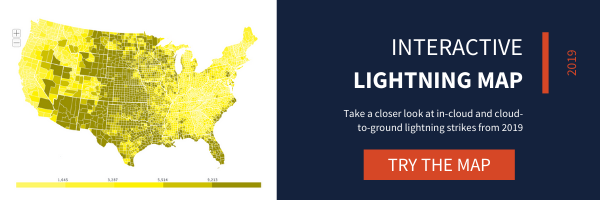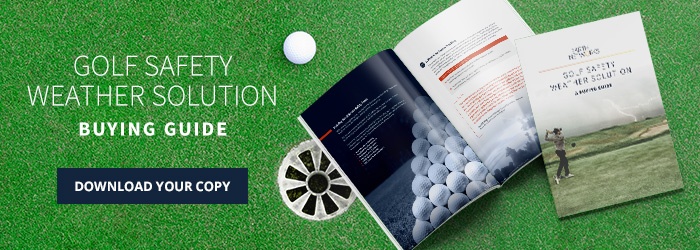2019 Club Safety Weather Report
 When it comes to country clubs and golf courses, there isn’t much that’s more important than customer satisfaction. While you have a lot to worry about, one of the most serious areas of risk for golf course management is the weather.
When it comes to country clubs and golf courses, there isn’t much that’s more important than customer satisfaction. While you have a lot to worry about, one of the most serious areas of risk for golf course management is the weather.
This club safety weather report from 2019 lays out the biggest threats and best ways to mitigate them at your golf course . Use the clickable table of contents below to jump to different areas of this report. You can jump back up to the table at any time by clicking “Back to Top.”
TABLE OF CONTENTS
Don’t Have Time to Read the Entire Report Now?
Download a PDF version of the piece you can reference later.
👇 Keep Scrolling to Start Reading!👇
About This Report
 When it comes to country clubs and golf courses, there isn’t much that’s more important than customer satisfaction. Since many members choose whether to renew their loyalty to your club each year, it is paramount to ensure they are completely satisfied. Even if you are a public course, golfers can always choose your competition if they don’t feel valued.
When it comes to country clubs and golf courses, there isn’t much that’s more important than customer satisfaction. Since many members choose whether to renew their loyalty to your club each year, it is paramount to ensure they are completely satisfied. Even if you are a public course, golfers can always choose your competition if they don’t feel valued.
Unfortunately for golf course professionals, there are many things that can go wrong at your club impacting the way your members and golfers feel about your establishment. Whether it’s something as simple as an inexperienced caddy dropping a bag of clubs or something more serious like a torn-up putting green; as management you want to minimize or eliminate these hiccups from occurring in the first place.
Club Management and Weather
While you have a lot to worry about, one of the most serious areas of risk for golf course management is the weather.
Let’s face it: You can’t control the weather.
Nobody can. Mother Nature is one of the few factors your management can only plan for instead of control. However, the weather can quickly cause serious injury or even death at your club, which won’t do you any favors when retaining current members or gathering new ones.
It could be a heavy rainstorm that floods your fairways. It could be tropical-storm force winds that knock out power to your clubhouse. In extreme yet common cases, it could also be that one rogue lightning strike that injures a member (although we hope that’s never the case).
Lightning Threat in Action

In fact, lightning is one of the most dangerous weather conditions at golf courses. This is partially due to how common thunderstorms can be.
An analysis from our total lightning network in 2018 showed that Plantation Preserve Golf Course & Club in Florida experienced 237,154 total lightning strikes in their immediate area, with 12,769 strikes being potentially deadly cloud-to-ground strikes. That’s just one year of lightning data for one of the golf courses we work with. How many near misses does your club have with lightning or other forms of severe weather?
Who Participated?
Where do you – as an industry – stand on severe weather safety? How are your peers mitigating severe weather risks and how successful are they at doing so? We wanted to find out.
The Earth Networks Club Safety Weather Survey was open to golf course professionals in the United States from July to September 2018. A total of 225 professionals took the 12-question survey about their club’s take on severe weather challenges initiatives, and solutions. Some of the most common job titles among the respondents included Head Golf Professional, General Manager, Director, PGA Professional, and Chief Operating Officer. Keep reading to see what we found.
Weather Concerns
Over 80% of clubs consider weather to be impactful to their operations

Just think about all the different ways severe weather can impact your operations. For example, heavy rains can soak or even rip up beautiful putting greens. High winds can knock out power to clubhouses or send debris all over the course. Lightning can strike golfers out of the blue. It’s clear that severe weather can affect any club at anytime, anywhere.
Weather Concerns: Frequency
Weather is such a big concern for your industry because it threatens your peers again and again. Just as lightning likes to strike the same place over and over again, severe weather complications are more likely to strike the same club more than once. Last year, 60% of clubs reported between 5-20 weather events that caused business disruptions.

Weather Concerns: Lightning
If we break down the overall weather concern into different conditions, 70% of clubs agree that lightning is the biggest weather-related concern.

When it comes to preparing for severe weather, you should also consider the big picture. You can ask yourself, “What are my biggest weather concerns?” For example, clubs in Florida might be more concerned about tropical weather than those in Montana, while those in Montana must take winter storms into account.
Remember: While your concerns will vary depending on your location, lightning can threaten any club no matter where you operate. You can see just how many total lightning strikes happen in your area with our U.S. Lightning Map.
Weather Safety
So how do you protect your patrons and staff from lightning and other threats from above? There are weather safety solutions that help golf courses and country clubs do just that. 70% of those surveyed reported having some type of weather safety solution on site.

Having a severe weather safety plan is the first step towards preventing severe weather from causing a catastrophe at your course. Preparedness is key when it comes to mitigating any type of risk. If you don’t already have a written plan in place, we highly recommend prioritizing this initiative and highlighting your plan to both your staff and members.
Weather Safety: Ineffective Solutions
The problem is, only 58% of respondents considered their solution effective.

Having the intent to protect patrons is not enough. You must have the right tools in place to protect your golfers, staff, and other guests. What good is a severe weather safety solution if you can’t rely on it 100% of the time?
Weather Safety: Lightning Detection Horns
That’s where lightning detection horns come in. Lightning detection horns are the most common piece of severe weather safety equipment used by your peers.

Unlike the outdated flash-to-bang method and temperamental lightning prediction horns, lightning detection horns are scientific, reliable, and trusted among your peers.
Severe Weather Planning
If you’re like those we surveyed, you plan on doing more to protect your organization from the risks of severe weather because safety is important to you. On average, we found that clubs reported an increase in weather safety spending in 2018 and only expect severe weather to be more impactful in the future.

Not surprisingly nearly 60% of all respondents indicated they perform a BIA at least every once each year since BIAs seem to be an industry best practice. A little over 20% of respondents conduct this assessment not even once per year. Some respondents indicated it’s on a 3 or 6-year plan while others explained they perform a BIA on a by-need basis.

When thinking about where you should spend and how much, you need to ask yourself some tough questions, like:
- What are you specific weather risks?
- How do you currently combat lightning risk?
- Are you comfortable with relying on antiquated lightning prediction “technology” or free weather apps?
- What is your available budget?
Severe Weather Planning: A Big Impact
No one likes answering these tough questions, but that’s why you’re in charge! It’s your job as a member of your club’s management team to think about these difficult subjects and make the right decisions.
If you’re reading through this report and think you worry too much about severe weather – you’re wrong. Over 80% of clubs surveyed consider the safety of patrons, staff, and guests from severe weather a top priority.
Over 80% of clubs surveyed consider the safety of patrons, staff, and guests from severe weather a top priority.
You’re not overreacting by researching severe weather safety solutions. Instead, you’re joining the intelligent majority of your industry in becoming a more responsible establishment.

Final Thoughts
The threat of severe weather isn’t going away. Thunderstorms, tornadoes, and hurricanes will continue to occur, and your club will have to deal with them. The best thing you can do is prepare before these threats do damage to your operations, finances, or people. If you haven’t already, it’s time to start drafting a severe weather safety plan.
Once you write down a plan and research solutions, it’s time to start crucial conversations with providers. Some tips for this step include keeping your specific weather threats in mind and asking the tough questions, like:
- Do you operate a lightning detection network?
- What are your products’ false alarm/missed alarm rates?
- How much does the solution cost?
- Is it customizable?
- What are the alerting options?
- Can it visualize weather threats?
- Can you show me my risks?
The road to comprehensive weather safety at your club start with understanding your specific risk. This last question is very important: Does your weather safety provider really understand the weather events that impact your facility?
If you want to know how many total lightning strikes our network detected at your club last year, click here. One of our weather experts will be in touch with a total lightning analysis for your club.
Thank you!
Thanks for reading our 2019 Club Safety Weather Report. If you want to come back to this resource, bookmark this page or fill out the form below for your forever copy.
Want to take a copy with you?
Download a PDF version of the report you can reference later.
Want to start building your own severe weather safety policy for your golf course? Download our free Club Safety Solutions Buying Guide and get ready to take some notes that will help your golf course be a safer place for patrons. They’ll thank you for it!




